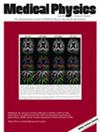Improving decomposition image quality in dual-energy chest radiography using two-dimensional crisscrossed anti-scatter grid
Abstract
Background
Chest radiography is a widely used medical imaging modality for diagnosing chest-related diseases. However, anatomical structure overlap hinders accurate lesion detection. While the dual-energy x-ray imaging technique addresses this issue by separating soft-tissue and bone images from an original chest radiograph, scattered radiation remains a significant challenge in decomposition image quality.
Purpose
This work aims to conduct dual-energy material decomposition (DEMD) in chest radiography using a two-dimensional (2D) crisscrossed anti-scatter grid to improve decomposition image quality by effectively removing scattered radiation.
Methods
A 2D graphite-interspaced grid with a strip density of N = 1.724 lines/mm and grid ratio r = 6:1 was fabricated using a high-precision sawing process. The grid characteristics were evaluated using the IEC standard fixture. A 2D-grid-based DEMD process, which involves the acquisition of low- and high-kV radiographs with a 2D grid, generation of a pairwise decomposition function using a calibration wedge phantom, and decomposition of soft-tissue and bone images using the decomposition function, was implemented, followed by software-based grid artifact reduction. Experiments were conducted on a commercially available chest phantom using an x-ray imaging system operating at two tube voltages of 70 and 120 kVp. The decomposition image quality of the proposed DEMD and conventional dual-energy subtraction methods was compared for the cases of no grid, software-based scatter correction, 1D grid (N = 8.475 lines/mm and r = 12:1), and 2D grid.
Results
The 2D grid demonstrated superior scatter radiation removal ability with scatter radiation transmission of 6.34% and grid selectivity of 9.67, representing a 2.6-fold decrease and a 2.7-fold improvement over the 1D grid, respectively. Compared to other competitive methods, the 2D-grid-based DEMD method considerably improved decomposition image quality, with improved lung structure visibility in selective soft-tissue images.
Conclusions
The proposed DEMD method yielded high-quality dual-energy chest radiographs by effectively removing scattered radiation, demonstrating significant potential for improving lesion detection in clinical practice.


 求助内容:
求助内容: 应助结果提醒方式:
应助结果提醒方式:


